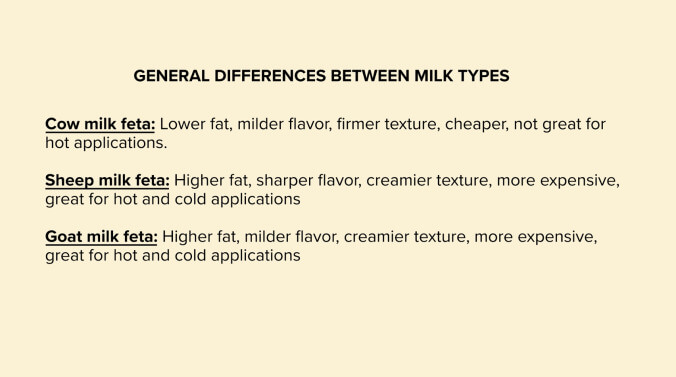Now is your chance to learn more about feta cheese than you ever thought possible
Sheep, goat, or cow milk? Packed in brine, or no? Block, or pre-crumbled? It's time to take a stand

The era of cheese neutrality is over, people. No longer can you expect to get away with simply sitting on the sidelines or hiding behind vague platitudes—the Feta Cheese Debate has begun, and it’s time to choose a side. Sorry, but we have no say in the matter; not after this feta breakdown (don’t laugh, this is serious) courtesy of YouTuber and chef, Ethan Chlebowski:
Yep, that is definitely over 7 minutes of information overload regarding everything there is to know about feta cheese, presented in an oddly impassioned tone that spurs one to make up their goddamn minds about the dairy product, once and for all. Did you know that feta often contains over double the normal cheese’s sodium content? As much as 5% salt-by-weight compared to a standard 1.5-2%. This is thanks to feta’s brining process… which is also something you need to have an opinion on now. But let’s not get ahead of ourselves.
“Let’s talk milk type,” Chlebowski declares at one point—okay, let’s. Apparently, there are generally three types of feta cheese made from either goat, sheep, or cow milk. Sometimes there’s a goat-sheep milk blend, but it has to be “no more than 30%” goat milk for it to be officially recognized as Greek feta cheese. There’s also distinctions based on flavor, texture, cost, and spreadability. Here’s a strangely business-like slide courtesy of Chlebowski to sum it all up:
Do not, under any circumstances aside from pain of death, purchase pre-crumbled feta. This is absolutely imperative, per our recent education. Aside from being unnecessarily lazy, “pre-crumbled have cellulose or starch added to cheese from caking” resulting in a large textural difference…
No, we’re not done talking about feta. Why would you think that? We haven’t even gotten to the damn brine, remember? You should.
Okay, brine: you need to have hardline thoughts on this, too. The right thought is buying feta that is still soaking in said brine, since it increases its shelf life by as much as 2-to-4 weeks after opening. “You can also use the brine afterwards to soak chicken, as well as make a vinaigrette,” suggests Chlebowski, as if you’d still have the energy or emotional bandwidth to handle such a project after these kinds of weighty, feta-based decisions. Of course, you could also just chuck a hunk of feta into the oven with some tomatoes and call it a day, as thousands on TikTok recently encouraged us to do.
[via Digg]
Send Great Job, Internet tips to [email protected]